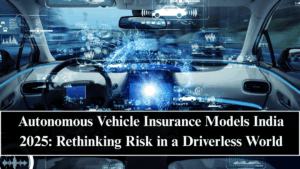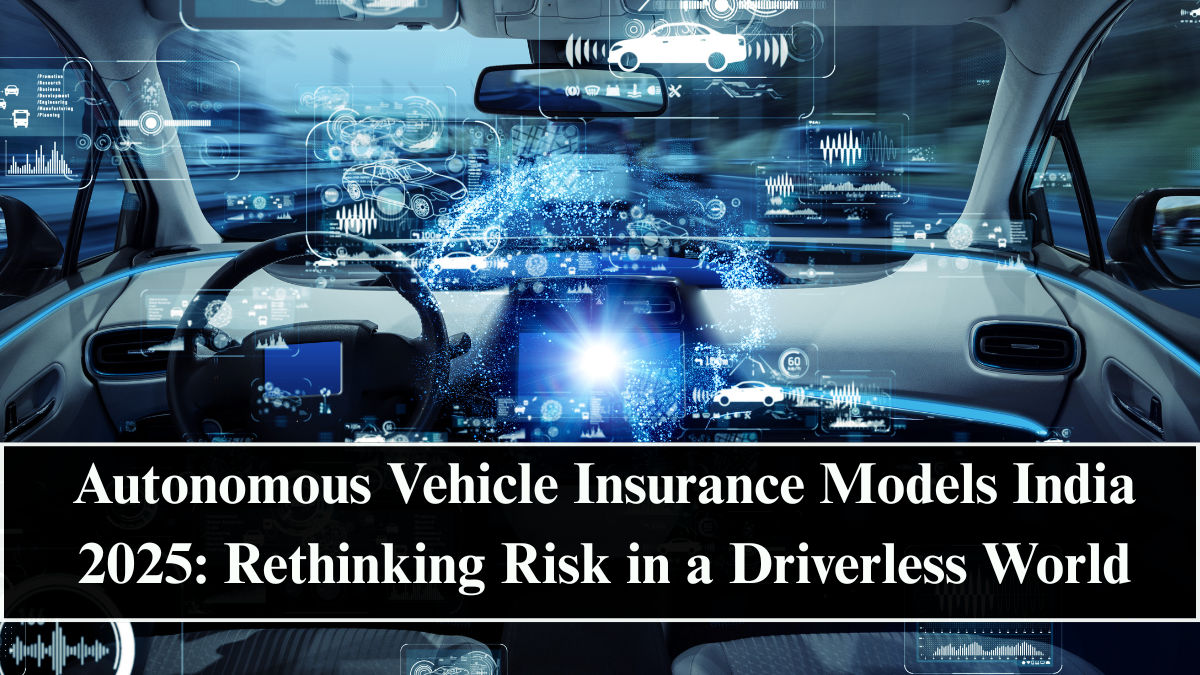With Autonomous Vehicle Insurance Models India 2025, India’s insurance industry is undergoing one of the most radical transformations in decades. As self-driving technology becomes reality, traditional vehicle insurance frameworks — built around human error — are being redefined to address AI-driven decision-making, shared responsibility, and real-time data accountability.
Autonomous and semi-autonomous cars are introducing new questions: Who is liable in case of an accident — the driver, the manufacturer, or the algorithm? How do insurers calculate risk when vehicles can make data-based decisions faster than humans? The answers lie in a new generation of insurance models powered by AI, telematics, and predictive analytics.

Why India Needs New Insurance Frameworks for Driverless Cars
By 2025, India’s autonomous mobility ecosystem includes ADAS-equipped vehicles, semi-autonomous delivery fleets, and AI-powered ride-hailing services. However, these advancements bring complex challenges for insurers:
-
Reduced Human Error: Over 80% of accidents are caused by driver mistakes. Automation drastically reduces this risk.
-
Shared Responsibility: Vehicle software updates, hardware sensors, and AI systems all play roles in accident outcomes.
-
Dynamic Risk Profiles: Every vehicle now has a constantly evolving safety record based on real-time driving data.
Insurance companies are responding by adopting usage-based, data-driven, and manufacturer-linked policies — models that assess both the machine and the human operator.
The Evolution of Insurance in the Autonomous Era
Traditional auto insurance models relied on static parameters like age, vehicle type, and claim history. In 2025, insurers are shifting to data-centric models that use real-time telematics and AI analytics to evaluate risk dynamically.
New model categories include:
-
Usage-Based Insurance (UBI):
Premiums depend on driving behavior, frequency, and time — all monitored via onboard sensors. -
Product Liability Coverage:
Focuses on manufacturers and software providers being partly responsible for system failures. -
Fleet and Platform Insurance:
Covers shared autonomous vehicles operated by companies or mobility platforms like Ola, Uber, and BluSmart. -
Cyber Risk Insurance:
Protects against hacks or data breaches in connected autonomous systems. -
AI Accountability Policies:
Designed to cover AI decision-making outcomes, algorithmic malfunctions, or misjudged navigation events.
The Role of Data and AI in Modern Risk Assessment
Data is the new backbone of the insurance industry. Through vehicle telematics, LiDAR sensors, and onboard diagnostics, insurers now receive second-by-second updates on how a car behaves in real conditions.
AI models process this information to calculate a dynamic risk score, factoring in:
-
Route difficulty and weather conditions.
-
Driver engagement level (for Level 2–3 autonomy).
-
Sensor accuracy and system reliability.
-
Frequency of manual overrides or software alerts.
Insurers such as ICICI Lombard, HDFC ERGO, and Tata AIG are already running pilot programs that combine AI analytics with real-time vehicle data, enabling instant claim validation and customized policy pricing.
Policy and Regulatory Developments in India
The Insurance Regulatory and Development Authority of India (IRDAI) is working closely with the Ministry of Road Transport and Highways (MoRTH) to design a comprehensive legal framework for autonomous vehicle insurance.
Key initiatives include:
-
Draft Autonomous Vehicle Safety and Insurance Code (AVSIC 2025) focusing on data transparency and shared liability.
-
Integration of Vehicle Identification Data (VID) for tracking software and sensor updates.
-
Legal definition of “operator” — covering both human drivers and AI systems.
These regulations aim to protect consumers while enabling innovation in connected mobility insurance.
Global Influence and Indian Adaptation
Globally, countries like the UK, Japan, and the US are experimenting with “no-fault” autonomous vehicle insurance models, where liability shifts from the driver to the vehicle manufacturer or system provider. India is adapting this framework while aligning it with local realities — such as mixed traffic conditions and varying road infrastructure.
Indian insurers are partnering with automotive OEMs like Hyundai, Mahindra, and Tata Motors to bundle insurance with connected car ecosystems. This means policy adjustments and claims can be processed automatically when incidents are detected by the car’s onboard systems.
The Future: On-Demand and Self-Managing Insurance
By 2025 and beyond, India’s insurance landscape is heading toward on-demand, blockchain-powered policies that activate when the car is in use and deactivate when parked.
Future models will also include:
-
Smart Contract-Based Claims: Automated settlement using blockchain verification.
-
AI-driven Policy Updates: Dynamic adjustments based on real-time driver and vehicle performance data.
-
Cross-Platform Data Sharing: Seamless collaboration between manufacturers, insurers, and regulators.
As AI and automation continue to evolve, the future of insurance will be transparent, adaptive, and integrated directly into vehicles, redefining the meaning of safety and accountability in mobility.
FAQs
What makes autonomous vehicle insurance different from traditional insurance?
It accounts for AI systems, shared responsibility between humans and machines, and real-time data-driven risk assessments.
Who is liable if an autonomous car causes an accident?
Liability may be shared among the driver, vehicle manufacturer, and software provider, depending on the system’s autonomy level.
Are Indian insurers ready for autonomous vehicles?
Yes, companies like ICICI Lombard and Tata AIG are testing AI-powered insurance products linked to connected vehicle data.
What is usage-based insurance (UBI)?
UBI calculates premiums based on driving patterns, system performance, and usage time rather than fixed parameters.
How will insurance evolve with fully autonomous cars?
Policies will become automatic and dynamic — with claims, payments, and pricing managed by AI and smart contracts in real time.
Click here to know more.
